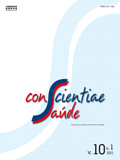Quality of life in active and sedentary elderly
DOI:
https://doi.org/10.5585/conscientiaesaude/2011/v10n1/2523Keywords:
Elderly, Exercise, Quality of life.Abstract
Objective: To analyze the quality of life in active and sedentary elderly and determine the factors that predicts their participation in exercises programs. Methods: A hundred and two elderly (mean age 69.1 ± 6.7 years) were divided into two groups: GAT, including the elderly inserted on a training program over than six months, and GC the control group made up of non-practicing. It was used a Medical Outcomes Study 36-Item Short Form Health Survey (SF-36) as a measure of quality of life. The differences between the two groups were analyzed by Mann Whitney test and multiple logistic regression estimated independently each transformed SF-36 scale (p<0,05). Results: It was observed that the scores obtained by GC were lower than most of domains of SF-36. Conclusion: Active elderly have better perception of quality of life, especially when analyzed the components related to functional capacity and social features.Downloads
Downloads
Published
How to Cite
Issue
Section
License
Copyright (c) 2011 ConScientiae Saúde

This work is licensed under a Creative Commons Attribution-NonCommercial-ShareAlike 4.0 International License.
Autores que publicam nesta revista concordam com os seguintes termos:
O(s) autor(es) autoriza(m) a publicação do texto na revista;
O(s) autor(es) garantem que a contribuição é original e inédita e que não está em processo de avaliação em outra(s) revista(s);
A revista não se responsabiliza pelas opiniões, idéias e conceitos emitidos nos textos, por serem de inteira responsabilidade de seu(s) autor(es);
É reservado aos editores o direito de proceder a ajustes textuais e de adequação às normas da publicação;
Autores mantém os direitos autorais e concedem à revista o direito de primeira publicação, com o trabalho simultaneamente licenciado sob uma Licença Creative Commons Atribuição-NãoComercial-CompartilhaIgual 4.0 Internacional;
Autores têm permissão e são estimulados a publicar e distribuir seu trabalho online (ex.: em repositórios institucionais ou na sua página pessoal) já que isso pode gerar alterações produtivas, bem como aumentar o impacto e a citação do trabalho publicado;
Em virtude de aparecerem nesta revista de acesso público, os artigos são de uso gratuito, com atribuições próprias, em aplicações educacionais e não-comerciais.



